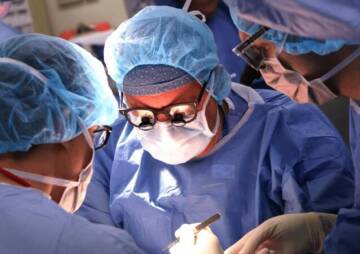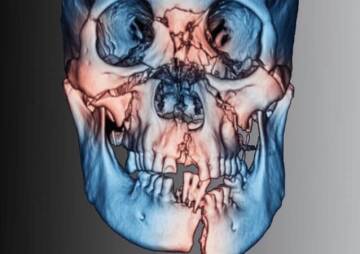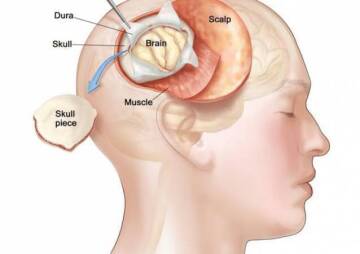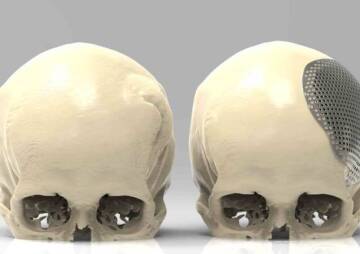-
Category
Craniomaxillofacial Surgery
Orthopedic Surgery
Spine Surgery
Orthopedic Implants
Hip Surgery
Knee Surgery
Pectus Excavatum
Bone Graft
Disinfectants
Healthcare
What is Crouzon Syndrome?
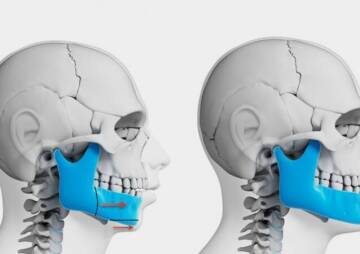
Crouzon syndrome surgery is a type of surgery where a genetic disorder is characterized by the fusion of individual skull bones, which are still premature during the initial days.
Crouzon syndrome surgery is a type of surgery where a genetic disorder is characterized by the fusion of individual skull bones, which are still premature during the initial days. This new fusion process prevents the skull of the individual from growing normally and later affects the head and face shape and makes it look abnormal. Crouzon syndrome has many features that result from the premature fusion that occurs in the bones of the skull. Crouzon syndrome leads to abnormal growth of bones to wide-set, popping eyes, problems of eyesight, beaked nose, eyes that do not point in the same direction, and underdeveloped jaws. People having Crouzon syndrome have an opening in the lip and at the palate in the mouth. Crouzon syndrome affected people who have average intelligence, and the syndromes vary from person to person.
Types of Crouzon Syndrome Surgery
These are some of the Crouzon syndrome surgeries that are usually prescribed.
Skull Base Surgery
The pediatric neurosurgeon, along with craniofacial surgeons work together to control and watch the pressure signs that are on the brain of the patient. Skull based surgery can be done in two types mainly. Most preferred skull base surgery is endoscopic, but open surgery is an option that depends on the growth type and the need for removing and the location.
Midface Surgery
Midface describes the location from the corners of the eyes to the area of the mouth, which includes the nose, upper lips, and cheeks. Midface surgery, a Crouzon surgery, is performed at the age of five or sooner if there are difficulties in breathing. In this case, the cheeks and the lower orbits become advanced, and techniques that encourage bone growth can be used in this case during the midface surgery.
Obstructive Sleep Apnea
Obstructive sleep apnea is a severe sleep disorder that causes difficulties in breathing during sleep. There are varieties of sleep apnea, but the common one is obstructive sleep apnea that occurs when the throat muscles relax and block the airways of the individual during sleep. Treatments for obstructive sleep apnea involve using a device that uses positive pressure and keeps the airways open while the individual is sleeping, use of mouthpiece to thrust the lower jaws, and to bring them forward while sleeping and the last option is surgery in some cases.
Minimally Invasive Skull Repair
Minimally invasive skull repair comes under Crouzon syndrome surgery. Minimally invasive skull repair involves the treatment of issues such as tumors, which are the hardest to have access to areas of the human body and diseases. During the early years, for the skull-based repair, big and deep incisions were being made, which took longer to heal and left scars behind. The chances of infection with such deep and big incisions were huge. With the help of new methods and technology, the surgeons use minimally invasive skull repair that needs smaller incisions that heal faster and leave no marks or the tumors and the adjacent region were removed through the nose without any skin incision. Nowadays, minimally invasive skull repairs are expanding, and the surgeons are putting active efforts for this purpose.
Fronto-orbital Advancement or Calvarial Vault Remodeling
Fronto- orbital Advancement or Calvarial Vault Remodeling is done to increase the space between the skull and the size of the two orbits. In this type of surgery, both the craniofacial surgeon and the pediatric neurosurgeon work together. Calvarial vault remodeling or reshaping the skull's misshapen bones, Whereas the fronto-orbital advancement, refers to the improvement of the forehead and the eyebrows towards forward in the patients in whom these mentioned areas are recessed.
Le Fort Advancement
Le Fort is one of the most commonly used treatments that correct the deformities in the midface. Correction in three dimensions is allowed with the help of Le Fort advancement. Before going for Le Fort advancement surgery, there should be proper orthodontics and surgical planning by the surgeon. In general, the surgery is widely used as it has fewer complications and has a reliable, long-lasting result.
Distraction Osteogenesis
Distraction osteogenesis makes a longer bone pout of a relatively shorter one. During the surgery, a bone is cut, and with the help of the distractor pulls, the bones are pulled apart slowly from each other. This stretching process is not painful. According to children, the pain of distraction osteogenesis is lesser than the braces they wear for straightening the teeth. Distraction osteogenesis allows more significant correction in the positioning of the bone than in the traditional surgery method. The process of distraction osteogenesis improves the results, and the child need not go for many surgeries later.

Monobloc Front Facial Advancement
Monobloc Front facial advancement, which is Crouzon syndrome surgery that represents the highest level of the maxillofacial osteotomy, which is performed without the craniotomy. In this process, the face is separated from the skull osteotomies across the orbit. Monobloc front facial advancement process was first performed in Mexico City in the year 1978, and the modification of the process was accomplished later in the year 1995. Monobloc front facial advancement process includes the process of removing the interorbital Naso-orbital-ethmoid bone for the purpose of overcorrection.
Segmental Subcarinal Distraction
The treatment of alveolar cleft of segmental subcarinal distraction osteogenesis is reported to minimize the cleft's size before the secondary bone grafting of the alveolar. This being a Crouzon syndrome surgery follows a latency period of 4 days' distraction and is applied for seven days at the rate of 0.5 mm daily. In the 8th week, the radiographic and clinical assessments revealed the formation of the new bones and tissues after segmental subcarinal distraction was over. The maxillary segment moved to minimize the width of the cleft and allowed a successful closure with alveolar bone graft.
Airway Treatments
Airways can be damaged due to accidents or trauma. A bad infection can even block and damage the airways as well. For the treatment of airway, Crouzon syndrome surgery procedures such as bronchoscopy, thoracentesis, lung volume reduction, VATS Lobectomy, pectus excavatum surgery, and thymectomy is performed.

Dental Treatment
Some of the conventional dental treatments that everyone has at least undergone are listed below. The dental treatment being a type of Crouzon syndrome surgery, plays a vital role in our life. Dental treatment is a treatment that an individual undergoes either for making the teeth to beautifying them. The conventional treatments are bonding, crowning, braces to straighten the teeth, bridges, and implants, which are in trend nowadays, crowns and caps, extractions, fillings, and repairs that even a small child has done, gum surgery and root canals. For cosmetic reasons, the veneers are used instead of crowns.
Osteotomy
The osteotomy surgery is done through the incision, which is made at the back of the patient's mouth right in the gum with the molar teeth to get access to the jaw. The incision is later made in the lower jaw in an oblique fashion with the help of a small saw which allows it to break in a controlled manner and then moved to its new place that has been preplanned and predetermined during the surgery with aiding to model the teeth. After the entire process, the gum is then stitched back again with the help of dissolvable stitches. The patient may have a small amount of bleeding from the mouth for a few days after the surgery. Sore throat and difficulties in swallowing are expected, so there is no need to panic.

Rhinoplasty
This is a surgery that changes the shape of the nose of the individual. It is trendy, and almost everyone is undergoing this surgery to look better. Rhinoplasty motivates to change the look of the nose, improve the breathing as well. We know that the lower part of the nose is cartilage, and the upper part is bone. With the help of the rhinoplasty, the bone, cartilage, and skin can be changed. It may not be appropriate for all to undergo the rhinoplasty, so it is better to talk to the surgeon before the surgery. If you are a candidate for the rhinoplasty surgery, then the surgeon will make a plan for you.
Genioplasty
Genioplasty, which is a form of cosmetic surgery, involves reshaping and repositioning of the chin and improve the facial harmony of the individual. Genioplasty is used to correct problems such as retrogenia, large or extended jaw, mandibles being too short, or too tall and abnormal dental bites. General anesthesia is used before the surgery, and depending on the genioplasty type, the recovery time varies. There are two types of genioplasty that are sliding genioplasty and implant augmentation. Around two nights, the patient has to be in the hospital after the surgery under the monitoring of the nurses to check and prevent infections. Genioplasty has some side effects such as bruising and redness, swelling, numbness, and loss of sensation and pain. Other rare but possible complications may include infection, allergic reaction to the materials of the implant, and the movement and changes in the implant position.
Frontal-orbital advancement, which is done to increase the space between the skull and the two orbits and the mid-facial promotion which is done if the child is having problems in breathing, are some types of Crouzon syndrome surgery types. Adding to these types of surgeries, the facial bi-partition is a type of Crouzon syndrome surgery type that widens the jaws of the upper part, rotates the orbit, and narrows the lower jaws.
Crouzon syndrome surgery, as we read above, has many types, and each type has its benefits that can be health benefits of beautifying benefits. The operations must be advised by the surgeon and then performed, so make sure you take proper advice from the right surgeon before undergoing the process. Do let us know if this content was helpful for you and was able to clear your doubts.

